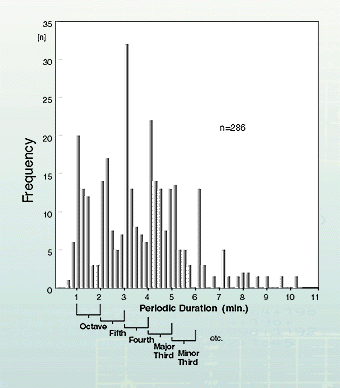In contrast, the rhythms of the metabolic system can no longer be modulated in their frequency. On the contrary, each functional area has a series of different pre-formed frequency bands which, according to the demands on performance, are utilized in a rapidly changing manner. All these frequency bands, however, relate to each other in simple whole numbered frequencies, and are so subject to a harmonic-musical order.
The rhythm of the stomach peristalsis, for instance, with its wave interval of approx. 20 seconds has a frequency ratio of 3:1 compared to the one-minute basic rhythm of the fundus musculature of the stomach and the contraction rhythm of the duodenum a ratio of 4:1 compared to the rhythm of the stomach peristalsis.
An isolated piece of smooth intestinal musculature shows spontaneous-rhythmic contractions whose periodic duration constantly changes in whole numbered jumps (illustration 8). There are probably musical-harmonic time structures embodied in each individual cell which correspond to the harmonic interval proportions.

